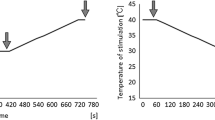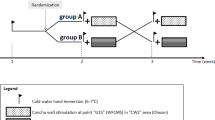Abstract
The present study was conducted to measure nasal mucosal blood flow (NMBF) during body warming. Five subjects [mean (SD) 24 (2) years], wearing only shorts and a thick felt hat with ear flaps, were immersed to the neck in a bath at 40 (0.5)°C. Tympanic (T ty), esophageal (T es), mean unweighted skin (T sk), nose skin and ear pinna skin were recorded at 1-min intervals. NMBF on the lower septal wall was estimated using a laser Doppler flow meter. At rest T ty and T es were both 36.5°C. T ty dropped significantly below T es during body warming, despite impeded heat loss from the head due to the felt hat. T ty increased to 37.3°C and T es increased to 37.5°C during the immersion. During the immersion all skin temperatures were steady or increasing, ruling out the possibility of a contamination of T ty from (T sk), Body warming significantly (P = 0.001) increased NMBF by approximately three times from resting values at the end of immersion. During the period of increasing core temperatures NMBF was significantly correlated to T ty (r = 0.93, P = 0.0001) and T es (r = 0.97, P = 0.0001), suggesting the blood flow change in this tissue was a thermo-regulatory response. The increased NMBF during hyperthermia supports the hypothesis of respiratory cooling involvement in selective brain cooling of humans.
Similar content being viewed by others
References
Baker MA (1982) Brain cooling in endotherms. Ann Rev Physiol 44:85–96.
Baker MA, Hayward IN (1967) Carotid rete and brain temperature of cat. Nature 216:139–141
Baker MA, Hayward IN (1968) The influence of nasal mucosa and carotid rete upon hypothalamic temperatures in sheep. J. Physiol (Lond) 198:571–579
Blix AS, Johnsen HK (1983) Aspects of nasal heat exchange in resting reindeer. J Physiol (Lond) 340:445–454
Brinnel H, Cabanac M (1989) Tympanic temperature is a core temperture in humans. J Therm Biol 14:47–53
Brengelmann GL (1993) Specialized brain cooling in himans? FASEB 7:1148–1153
Cabanac M (1993) Selective brain cooling in humans: “fancy” or fact? FASEB 7:1143–1147
Cabanac M, Brinnel H (1985) Blood flow in the emissary veins of the human head during hyperthermia. Eur J Appl Physiol 54:172–176
Cabanac M, Caputa M (1979a) Open loop increase in trunk temperature produced by face cooling in working humans. J Physiol (Lond) 289:163–174
Cabanac M, Caputa M (1979b) Natural selective cooling of the human brain evidence of its occurrence and magnitude. J Physiol (Lond) 286:255–264
Cabanac M, White M (1995) Core temperature thresholds for hyperpnea during passive hyperthermia in humans. Eur J Appl Physiol (in press)
Caputa M (1979) Temperature gradients in the nasal cavity of the rabbit. J Therm Biol 4:283–286
Caputa M, Perrin G, Cabanac M (1978) Écoulement sanguin reversible dans la veine opthalmique: Mécanisme de refroidissment sélectif du cerveau humain. CR Acad Sci Paris t. 287:1011–1014
Caputa M, Kamari A, Wachulec M (1991) Selective brain cooling in rats resting in heat and during exercise. J Therm Biol 16:19–24
Cauna N (1970) The fine structure of the arteriovenous anastomosis and its nerve supply in the human nasal respiratory mucosa. Anat Rec 168:9–22
Chmielowa M, Kielczewska-Mrozikiewicz D, Skuratowicz A (1980) Tympanic temperature in some diseases with fever (in Polish) Rocz Akad Med Poznam X25:157–160
Cole P (1954) Respiratory mucosal vascular responses, air conditioning and thermoregulation. J Laryngol 68:613–622
Deklunder GM, Dauzat M, Lecroart J-L, Hauser J-J, Houdas Y (1991) Influence of ventilation of the face on thermoregulation in man during hyper- and hypothermia. Eur J Appl Physiol 62:342–348
Drettner B (1961) Vascular reactions of the human nasal mucosa on exposure to cold. Acta Otolaryngol 166 [Suppl]:1–109
Druce HM, Bonner RF, Patow C, Choo P, Summers RJ, Kaliner MA (1984) Response of nasal blood flow to neurohormones as measured by laser Doppler velocimetry. J Appl Physiol 57:1276–1283
Elkhawad AO, Al-Zaid NS, Bou-Resli MN (1990) Facial vessels of desert camel (Camelus dromedarius): role in brain cooling. Am J Physiol 258:R602-R607
Fuller CA, Baker MA (1983) Selective regulation and body temperature in the squirrel monkey. Am J Physiol 245: R293-R297
Gaudio Jr, Abramson N (1968) Heat-induced hyperventilation. J Appl Physiol 25:742–746
Gordon C, Rezvani AH, Fruin ME, Ttautwein S, Heath JE (1981) Rapid brain cooling in the free running hamster (Mesocricetus auratus). J Appl Physiol 51:1349–1354
Haldane JS (1905) The influence of high air temperatures. J Hyg 55:497–513
Hales JRS, Dampney RAL (1975) The redistribution of cardiac output in the dog during heat stress. J Therm Biol 1:29–34
Hales JRS, McConaghy FF, Hodgson DR (1993) Limited selective brain cooling in the horse during exercise. In: Milton AS (ed) Thermal Physiology. Proceedings of the IUPS Thermal Physiology Commission symposium. BPCC-AUP, Aberdeen, p 41
Hanson R de G (1974) Respiratoru heat loss at increased core temperature. J Appl Physiol 37:103–107
Jessen C, Kuhnen G (1992) No evidence for brain stem cooling during face fanning in humans. J Appl Physiol 72:664–669
Johnsen HK, Blix AS, Jorgensen L, Mercer JB (1985) Vascular basis for regulation of nasal heat exchange in reindeer. Am J Physiol 249: R617-R623
Magilton JH, Swift CS (1968) Description of the two physiological heat exchange systems for the control of brain temperature. In: I.E.E.E. Conference record, 5th Annual Rocky Mountain Bioengineering Symposium, 6–7 May pp 24–27
Mariak Z, Lewko J, Luczaj J, Polocki B (1993) The direct relationship between human cerebral and tympanic temperatures as demonstrated with manipulation of brain temperature. In: Milton AS (ed) Thermal physiology, Proceedings of the IUPS Thermal Physiology Commission Symposium. BPCC-AUP, Aberdeen Ltd, Aberdeen, p 78
Mekjavic IB, Rempel ME (1990) Determination of esophageal probe insertion length based on standing and sitting height. J Appl Physiol 69:376–379
Nagasaka T, Brinnel H, Hirata K, Noda Y, Sugimoto N (1989) Increase in venous flow through opthalmic veins enhanced selective brain cooling in hyperthermic humans. In: Mercer JB (ed) Thermal physiology. Elsevier, Amsterdam, pp 205–210
Negus VE (1965) The biology of respiration. Livingstone, Edinburgh
Nielsen B, Jessen C (1992) Evidence against brainstem cooling by face fanning in severely hyperthermic humans. Pflügers Arch 442:168–172
Pleschka K, Kuhn P, Nagai M (1979) Differential vasomotor adjustments in the evaporative tissues of the tongue and nose in the dog under heat load. Pflugers Arch 382:255–262
Ralston HF, Kerr WMJ (1945) Vasular responses of the nasal mucosa to thermal stimuli with some observations on skin temperature. Am J Physiol 144:305–310
Rasch W, Samson P, Coté P, Cabanac M (1991) Heat loss from the human head during exercise. J Appl Physiol 71:590–595
Shiraki K, Sagawa S, Tajima F, Yokota A, Hashimoto M, Brengelmann GL (1988) Independence of brain and tympanic temperatures in an unanesthetized human. J Appl Physiol 65:482–486
Spiesman IG (1936) Vasomotor reactions of the mucosa of the upper respiratory tract to thermal stimuli. Am J Physiol 115:181–187
Taylor CR, Lyman CP (1972) Heat storage in running antelopes; independence of brain and body temperatures. Am Physiol 222:114–117
White MD, Cabanac M (1992) Physical dilatation of the nares lowers thermal strain in exercising humans. In: Lotens WA, Havenith G (Eds) Environmental ergonomics. Proceedings of the 5th International congress of environmental ergonomics. TNO Press, Soesterberg, Netherlands, pp 220–221
White MD, Cabanac M (1993) Exercise hyperpnea and selective brain cooling in humans (abstract). FASEBJ 7:A16
Author information
Authors and Affiliations
Rights and permissions
About this article
Cite this article
White, M.D., Cabanac, M. Nasal mucosal vasodilatation in response to passive hyperthermia in humans. Eur J Appl Physiol 70, 207–212 (1995). https://doi.org/10.1007/BF00238565
Accepted:
Published:
Issue Date:
DOI: https://doi.org/10.1007/BF00238565




